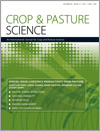This study examined whether the productivity and persistence of mixed pastures that included subterranean clover (Trifolium subterraneum L.), lucerne (Medicago sativa L.), and/or phalaris (Phalaris aquatica L.) were improved if species were spatially separated rather than being sown together in each drill row. The study also compared the productivity and persistence of subterranean clover with alternative annual legume species biserrula (Biserrula pelecinus L.) and strand medic (Medicago littoralis Rhode ex Loisel). Twelve pasture treatments were sown in replicated field experiments at five locations across the medium-rainfall region of south-western New South Wales in 2012 and monitored for 3 years. Pastures that included lucerne, phalaris and subterranean clover were generally more productive than pastures with only one or two of those species, regardless of sowing configuration. Averaged across sites, subterranean clover regeneration in year 3 was 29% higher and total cumulative biomass 13% higher where subterranean clover was sown in a 1 : 1 configuration with lucerne than where the species were mixed together in every drill row. There were fewer consistent benefits of alternative spatial configurations on swards containing phalaris with subterranean clover or with lucerne. Results of the present study appeared to be highly site-specific, or season-dependent, and therefore alternative spatial configurations cannot be recommended as a universal strategy at this time. More research is required to understand the factors driving the responses to alternative spatial configurations observed in the present study.
Neither biserrula nor strand medic was superior to subterranean clover in a 3-year pasture phase with lucerne, despite abundant rhizobia compatible with all species at all sites. The density of subterranean clover in year 3 was 29% and 41% higher than of biserrula and strand medic, respectively. A narrow choice of adapted cultivars as well as excessive levels of hard seed for the legumes used in phased pastures with lucerne are suggested as contributing to the inferior performance of the alternative legumes species tested in the study.





